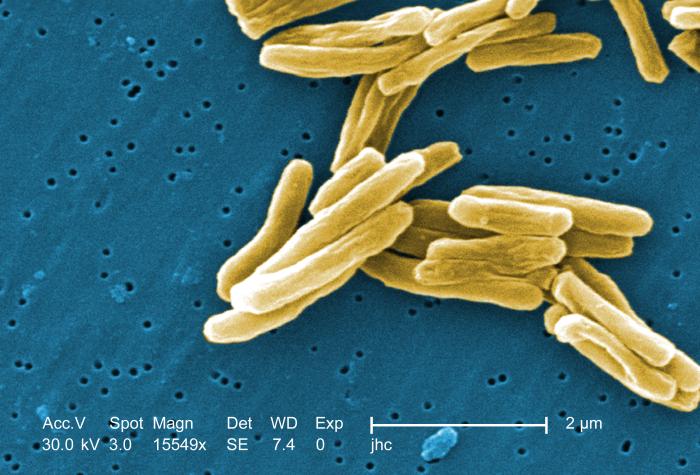Big consequences from tiny life
Research digs deeper into the effects of soil microbes on a warming environment
Katherine Ellen Foley • October 27, 2014

Bacteria may increase carbon dioxide in the atmosphere more than previously considered by climate scientists. [Image credit: Flickr user Microbe World]
Though they’re invisible to the naked eye, soil-dwelling microbes — single-cell organisms such as fungi and bacteria — may have a very detectible impact on global temperatures. These organisms convert solid carbon stored into the ground into the greenhouse gas carbon dioxide, which is then released into the atmosphere.
A study published in Nature in September found that if soil samples were warmed 3 degrees Celsius above their average annual temperatures for 90 days, microbes changed more solid carbon into carbon dioxide than they do normally. This process, known as respiration, is similar to the way we eat and breathe to produce energy.
“Soils are the largest reservoirs of carbon on our planet,” says Brajesh Singh, a microbial ecologist from the University of Western Sydney in Australia and co-author of the paper. Since soils store 1,500 to 2,000 billion tons of carbon, additional CO2 emissions from heated-up microbes could amplify the effects of global warming even more than current climate change models have predicted.
The researchers were faced with unique challenges because they were working with single-cell organisms, whose life cycles may change based on their environment. As temperatures increase, microbial growth rates go up, according to soil ecologist Paul Dijkstra from the University of Northern Arizona in Flagstaff, AZ, who was not affiliated with the paper. This means that when scientists warm soil samples, they have to make sure that they measure only extra carbon dioxide produced as a result of faster metabolism, and not just the presence of more microbes.
In order to control for this phenomenon, the researchers cooled soil samples and extrapolated data backwards.
The researchers sampled soil from 22 sites ranging from the Arctic Circle to near the equator. They calculated that microbes in the soils with the coldest average temperatures and the highest amounts of stored carbon are the most sensitive to temperature change. These microbes could generate more than six times the normal amount of carbon dioxide if their environment increases by 10 degrees. According to Mark Bradford, an ecologist at Yale University, this effect has not been found in prior studies, which only examined short-term changes in soil microbial respiration in warmer climates.
But Bradford says there is a major error in the methodology that may invalidate the paper’s claims. Soils from the highest latitudes have average temperatures below freezing, at which single-cell life must produce antifreeze-like chemicals to keep from freezing. For these samples, the researchers held the soil samples at 7 degrees and then cooled them to 1 degree. At just above freezing, “[microbes] are going into a phase where they don’t want to die…which is not a normal biological response,” Bradford said. In other words, soil microbes’ last-ditch effort to survive does not accurately represent their everyday behavior.
However, Singh dismisses these concerns, citing previous experiments that show the majority of microbial activity in cold soils occurs during the few months in which the temperatures are above freezing. “We strongly believe that the temperature range in our study is highly relevant to understanding microbial processes in cold soils,” he said. Dijkstra believes the study’s results show a need for additional research. “There are important microbial mechanisms that need to be explored before we can make accurate predictions,” he said. Dijkstra and his team recently published a paper showing that sustained increases in soil temperatures cause microbes to replicate more over long periods of time. His work does not contradict this study, but rather suggests that climate change modelers may have to consider the compound effects of elevated CO2 production from a greater number of microbes than previously considered.
Singh said that the team now plans to investigate how soil microbes respond to prolonged temperature change, which appears to be different from the way animals and plants adapt to these changes over time. It may be that microscopic life forms visibly impact global warming.
1 Comment
Algae: no. Triops quickly grow beynod the algae-eating stage.Other aquatic plant life: maybe. They’re omnivorous; I never tried setting on on an all-vegetarian diet. A problem I’ve found with Triops is that they tend to be fragile, die for no particular reason, and even when everything seems to be going well, die at about six weeks anyway.A better choice for a biosphere might be either ostracods ( seed shrimp ) or cyclops for fresh water. You can get these critters from pond mud.Near where I live, I used to be able to get small freshwater limpets that would eat biofilm algae. I’d find them on the sides of leaves of water hyacinth.If you’re okay with saltwater, you can try brine shrimp.I was resonsible for the rodent section being invented.